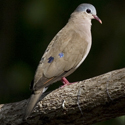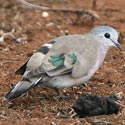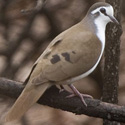|
Genus: Turtur
Life
> Eukaryotes >
Opisthokonta
> Metazoa (animals) >
Bilateria >
Deuterostomia > Chordata >
Craniata > Vertebrata (vertebrates) > Gnathostomata (jawed
vertebrates) > Teleostomi (teleost fish) > Osteichthyes (bony fish) > Class:
Sarcopterygii (lobe-finned
fish) > Stegocephalia (terrestrial
vertebrates) > Tetrapoda
(four-legged vertebrates) > Reptiliomorpha > Amniota >
Reptilia (reptiles) >
Romeriida > Diapsida > Archosauromorpha > Archosauria >
Dinosauria
(dinosaurs) > Saurischia > Theropoda (bipedal predatory dinosaurs) >
Coelurosauria > Maniraptora > Aves
(birds) > Order: Columbiformes > Family:
Columbidae
Species indigenous to southern Africa
|
Turtur afer
(Blue-spotted wood-dove, Blue-spotted dove) The
Blue-spotted wood-dove occurs across sub-Saharan Africa, absent from large
areas of east-central and southern Africa. It usually occurs on the edges of
evergreen or gallery forest, occasionally moving into the surrounding bush.
Its diet has not been properly studied, however it is probably omnivorous,
foraging mainly on the ground. The nest is a fragile saucer, made up of
twigs, petioles and rootlets, usually placed on a leafy stump, tree or bush.
Here it lays about 2 eggs, which are incubated for about 15-17 days. The
chicks stay in the nest for roughly 15-18 days (recorded in captivity). |
 |
|
Turtur
chalcospilos (Emerald-spotted wood-dove, Greenspotted dove)
The Emerald-spotted wood-dove is fairly common in many parts of southern
Africa, living in woodlands, savanna and valley bushveld. It forages on
sparsely vegetated ground, looking for fallen seeds and fruit, although
little more is known of its diet. It builds its own nest, which is a
platform of twigs, stems and roots, placed 0.5-6 metres above ground in a
tree, bush or Aloe. It lays 1-2 eggs, which are incubated mainly by the
female, for 17 days. The chicks stay in the nest for 15-17 days, before
leaving. |
 |
|
Turtur
tympanistria (Tambourine dove) The
Tambourine dove occurs across sub-Saharan Africa, from Senegal to Uganda
south to southern Africa. Here it is locally common in riverine woodland and
evergreen forest, often occupying coastal forest in the Western and Eastern
Capes. It eats a variety of fruit, seeds and invertebrates, usually foraging
on the ground. Both sexes construct the nest, which is a fragile saucer made
of twigs, leaves and petioles, placed in tangled creepers, bushes or trees.
Here it lays 1-2 eggs, which are incubated mainly by the female for about
17-20 days .The chicks are fed about four times daily by both parents, who
regurgitate food eaten previously. They are brooded constantly for the first
few days of their lives, staying in the nest for about 19-22 days. |
 |
|
